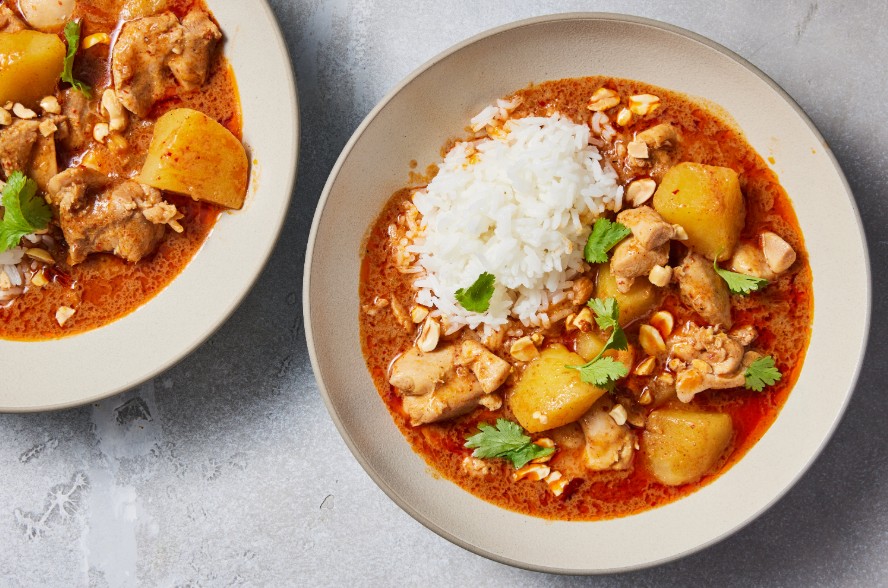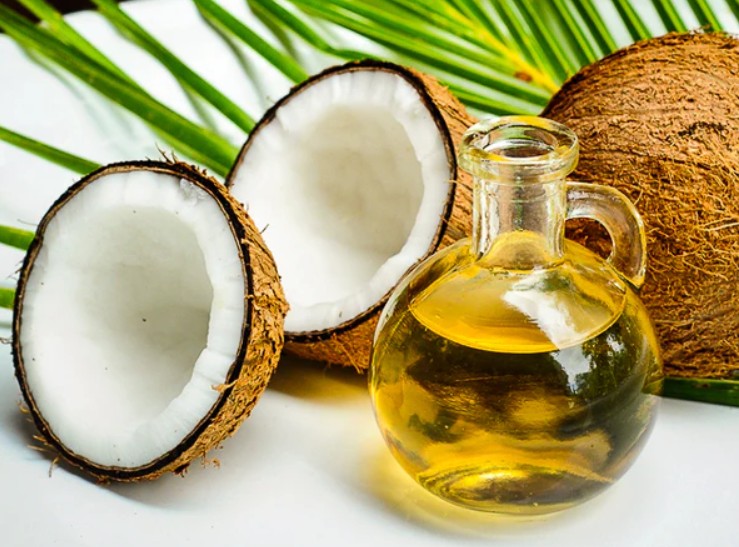
Plum and frangipane tart
(pictured top)
I am extremely enamoured by fruit tarts. They always feel celebratory with their glistening tops and flaky bottoms. This one is a perfect combination of almonds, in the way of frangipane, and wonderfully perfumed plums. It is a great dessert to make ahead of time as it will sit happily on the kitchen bench at room temperature.
6 plums, halved and stones removed, sliced
1 egg, for egg wash
Demerara sugar, for sprinkling
For the sweet pastry
400g plain flour, plus extra for dusting
A pinch of sea salt
2 tbsp caster sugar
250g cold unsalted butter, cubed
1 tbsp white vinegar
About 100ml iced water
For the frangipane
75g unsalted butter, softened
75g caster sugar
1 tsp vanilla bean paste or extract
75g almond meal
1 egg
1 tbsp plain flour, sifted
To make the sweet pastry, mix the flour, salt and sugar together in a large bowl. Rub the butter into the flour using your fingertips or a pastry cutter until the mixture is pebbly. You want to rub the butter into flatter pieces rather than into something that resembles breadcrumbs. Drizzle in the vinegar and enough iced water to just bring the dough together. It will still be shaggy, but should hold together when pressed and not be dry or floury. Flatten into a disc, wrap in plastic wrap and refrigerate for at least one hour.
Remove the pastry from the fridge and let it sit at room temperature for 10 minutes to make it easier to roll. Line a 30cm round baking tray with baking paper.
Roll the dough out on a lightly floured work surface into a large circle about 1.5mm thick, massaging the edges as you roll to prevent it from cracking too much. Drape the pastry over the prepared tray and keep refrigerated until needed.
To make the frangipane, place the butter, sugar and vanilla in the bowl of a stand mixer fitted with the paddle attachment. Beat on high speed for about four minutes, until creamy and pale, then beat through the almond meal, egg and flour until combined.
To make the tart, spread the frangipane onto the base of the pastry, leaving a 1.5cm border. Arrange the plums on top of the frangipane filling, then fold the pastry edge over itself to create a ridged edge.
Whisk the egg with 1 teaspoon of water, then brush the egg wash over the pastry edge and scatter generously with demerara sugar. Refrigerate the tart for 30 minutes.
Preheat the oven to 190C.
Bake the tart for 40 minutes or until the pastry is golden. Allow to cool before serving.
Panna cotta with roasted nectarines and blueberries
Panna cotta translates to “cooked cream” and it is one of my favourite Italian desserts. Luckily, it also happens to be one of the simplest. I love it just set – panna cotta should have a good wobble and sit on the plate droopily rather than incredibly stiff. Mine is lightly perfumed with bay and lemon and heavily scented with vanilla. Served with some lightly poached or roasted fruits – nectarines or apricots in summer, rhubarb in spring, and citrus in winter – panna cotta is such an elegant dessert, and an absolute joy to make.
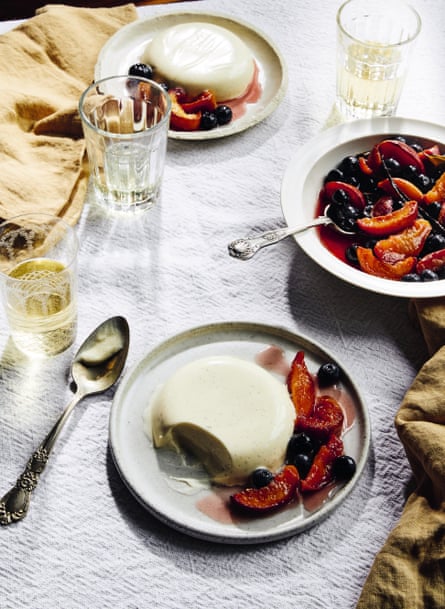
Serves 4
500ml pure cream
1 vanilla pod, split and seeds scraped
3 strips lemon peel
1 fresh bay leaf
80g caster sugar
2 titanium-strength gelatine leaves
200g creme fraiche
Ice cubes
125g blueberries
Boiling water
For the roasted nectarines
5 nectarines, halved and stones removed, cut into wedges
2 tbsp raw sugar
Place the cream in a saucepan with the vanilla seeds and pod, lemon peel and bay leaf. Bring to a simmer over medium heat and cook for two minutes or until slightly thickened – don’t let it boil. Add the sugar and whisk to dissolve, cooking the cream for a further one minute. Remove from the heat.
Meanwhile, soak the gelatine leaves in a bowl of cold water until softened. Squeeze the excess water from the gelatine and whisk it into the cream mixture. Whisk in the creme fraiche, then strain the mixture through a fine sieve into a bowl. Reserve the vanilla pod, bay leaf and lemon peel.
Sit the bowl in a larger bowl filled with ice cubes and whisk the mixture for eight to 10 minutes, until cool. Pour the mixture into a large jug and then divide among four small bowls or ramekins. Chill in the fridge for five hours or until just set. Once the panna cotta has set, cover each bowl or ramekin with plastic or beeswax wrap and return to the fridge.
While the panna cotta is setting, prepare the roasted nectarines. Preheat the oven to 180C. Place the nectarines in a deep baking tray so they are nice and snug and scatter over the sugar. Rinse the vanilla pod, bay leaf and lemon peel that you used to flavour the cream. Add these to the nectarines along with 125 ml of water. Roast in the oven for 30 minutes or until the fruit is tender.
Transfer the nectarines to a large bowl and add the blueberries. Stir to combine and allow to completely cool. You can store the fruit in a container in the fridge until ready to serve.
Dip each panna cotta bowl or ramekin into a bowl filled with boiling water for 20 seconds, then invert onto plates. Serve with the roasted nectarines and blueberries.
Peach custard tart
There is something quite nostalgic, almost child-like, about the combination of peaches and custard. Here I’ve taken that combination and turned it into a rather large peach tart, spiked with lemon and nutmeg, that’s absolutely made for sharing. The pastry and custard can be made well in advance and kept in the fridge until ready to bake.
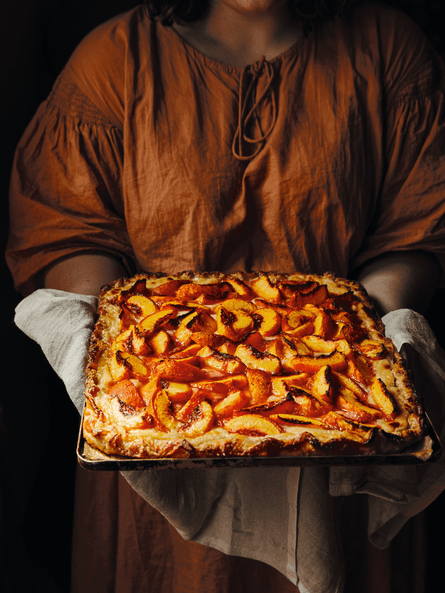
Serves 10-12
500g plain flour, plus extra for dusting
A pinch of sea salt
1 tbsp caster sugar
300g cold unsalted butter, cubed
1 tbsp white vinegar
About 200ml iced water
1 egg, for egg wash
2 tbsp demerara sugar
For the custard
2 egg yolks
100g caster sugar
20g plain flour
20g cornflour
500ml full cream milk
1 vanilla pod, split and seeds scraped
For the peaches
1.2kg peaches (about 8)
Iced water
A pinch of freshly grated nutmeg
3 tbsp caster sugar
Juice of ½ lemon
1 vanilla pod, split and seeds scraped
Mix the flour, salt and sugar together in a large bowl. Rub the butter into the flour using your fingertips or a pastry cutter until the mixture is pebbly. You want to rub the butter into flatter pieces rather than into something that resembles breadcrumbs. Sprinkle the vinegar over the top, then pour over enough iced water to just bring the dough together. It will still be shaggy, but should hold together when pressed and not be dry or floury. Flatten into a disc, wrap in plastic wrap and chill in the fridge for at least one hour.
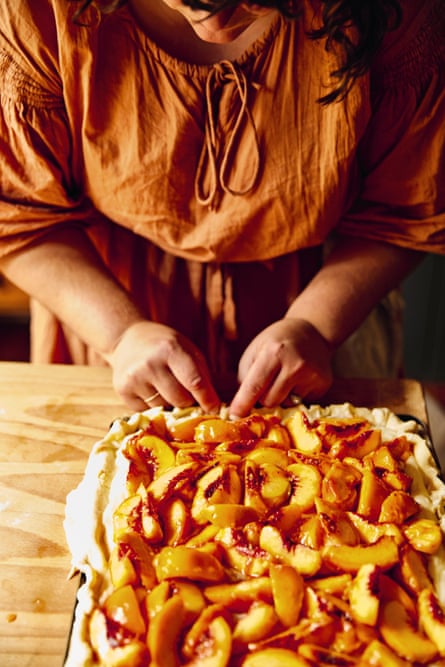
To make the custard, whisk the egg yolks and sugar in a large bowl, until pale and thick. Sift in the flours, mix well and set aside. Warm the milk and the vanilla seeds and pod in a saucepan over low heat (until about 38C on an instant-read thermometer). Strain the milk and add to the egg mixture, just a few tablespoons at a time to begin with, whisking between each addition. After a quarter of the milk has been whisked in, whisk in all of the remaining milk at once. Pour the mixture into a clean saucepan and set over medium heat. Bring to a simmer, whisking constantly as it can scorch easily. Reduce the heat to low and cook, stirring constantly, for two to three minutes, until thick. Transfer to a bowl or container and cover the surface of the custard with plastic wrap. Make sure it is directly touching the custard, to stop a skin forming, then refrigerate until ready to use.
To prepare the peaches, with a knife, cut a shallow cross in the base of each peach. Blanch the peaches in a saucepan of boiling water for 30 seconds to one minute, then drain and refresh in iced water. The skins should now slip away. Cut the peaches in half, remove the stones and slice into wedges. Place in a large bowl with the nutmeg, sugar, lemon juice and vanilla seeds. Toss to combine and set aside.
Preheat the oven to 190C. Line a 40 cm × 25 cm baking tray with baking paper.
Remove the dough from the fridge and let it sit at room temperature for 10 minutes to make it easier to roll. On a lightly floured work surface, roll the dough out into a large rectangle, about 45cm × 30cm, massaging the edges as you roll to prevent it from cracking too much. Drape the pastry over the prepared tray.

Spread the custard over the base of the pastry, leaving a 4cm border. Arrange the peach wedges on top of the custard, then fold the pastry border in towards the tart to create a raised edge. Whisk the egg with one teaspoon of water and brush the pastry edges with the egg wash. Scatter the edges with the demerara sugar and bake for 45to 50 minutes, until the pastry is golden. Serve at room temperature.

